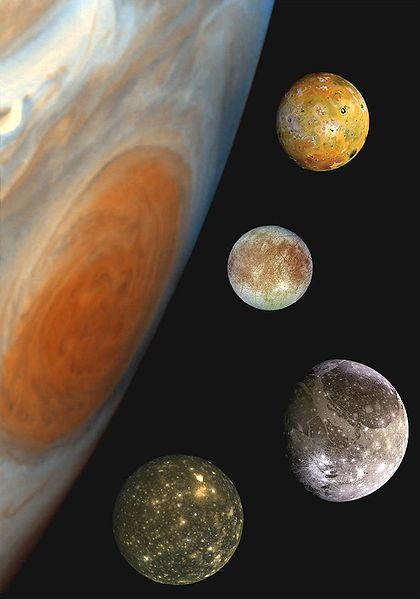
In this day of cellphone GPS applications and vehicle navigation systems we forget that knowing exactly where you are on earth used to be a huge problem. It was especially acute at sea where there aren’t any landmarks.
Until an accurate marine clock was invented in 1737 and became affordable in the 1780’s, seaman used the position of the sun, stars and planets to determine their location. This worked well for north and south (latitude) but was impossible for determining east-west (longitude) because the earth rotates in that direction.
Shipwrecks occurred frequently, even under the best sea captains, and kings offered enormous prizes to the person who could solve the longitude problem. Astronomers looked for a spot in the sky that behaved predictably and independently of the Earth’s orbit.
Galileo found an answer in Jupiter’s moons.
After he perfected the telescope in 1609, Galileo discovered the four largest moons of Jupiter. He carefully logged their orbits and noted how often they disappeared behind the planet. His records showed their orbits are so predictable you can tell time by them. This was an answer to the longitude problem.
But it didn’t work at sea. If you’ve ever viewed Jupiter through your binoculars you know that your heartbeat can make the planet jump. No one could see the moons’ eclipses on a rolling boat deck. However the method worked well on land with a tripod.
By 1650, the eclipses of Jupiter’s moons were so well documented that mapmakers used them to redraw the world. Finally there were accurate land maps! King Louis XIV of France reportedly complained that he was losing more territory to his astronomers than to his enemies (*).
Twenty-six years later Jupiter helped calculate the speed of light when Danish astronomer Ole Rømer discovered that the eclipses occurred sooner than expected when the Earth was closest to Jupiter and later than expected when Earth and Jupiter were furthest apart. The difference is the speed of light.
Today Jupiter will rise at 2:00pm but his transit will go largely unnoticed. His moons still keep accurate time but his role is eclipsed by our wristwatches, cellphones and satellites.
.
(Composite photo of Jupiter with its Galilean moons by NASA on Wikimedia Commons. Click on the image to read how it was constructed.)
.
(*) This quote is from Dava Sobel’s book, Longitude: The True Story of a Lone Genius Who Solved the Greatest Scientific Problem of His Time, where I learned these facts about Jupiter. I highly recommend her book, published by Penguin in 1995. Click on the book link to find it on Amazon.
I, too, can recommend the book by Sobel as a very interesting read !
We learn something new everyday! If the topic is of interest you might find this
a facinating book, “Galileo’s Daughter” by Dava Sobel (Penquin books). Her other titles are also of interest, “Longitude” and coauthor of “The Illustrated Longitude”. This fall her latest, with Copernicus as the subject, was published. I haven’t read it yet but am looking forward to it. It has had excellent reviews.
Sobel’s book is very fascinating and worthy of anyone’s attention. Nowadays IS binoculars settle the moons very nicely.